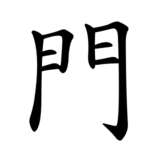| 門 | ||||
|---|---|---|---|---|
| ||||
| 門 (U+9580) "gate, door" | ||||
| Pronunciations | ||||
| Pinyin: | mén | |||
| Bopomofo: | ㄇㄣˊ | |||
| Wade–Giles: | men2 | |||
| Cantonese Yale: | mun4 | |||
| Jyutping: | mun4 | |||
| Japanese Kana: | モン mon (on'yomi) かど kado (kun'yomi) | |||
| Sino-Korean: | 문 mun | |||
| Hán-Việt: | môn, món, mon | |||
| Names | ||||
| Chinese name(s): | 門字框/门字框 ménzìkuàng | |||
| Japanese name(s): | 門構/もんがまえ/かどがまえ mongamae/kadogamae | |||
| Hangul: | 문 mun | |||
| Stroke order animation | ||||
 | ||||

Radical 169 or radical gate (門部) meaning "gate" or "door" is one of the 9 Kangxi radicals (214 radicals in total) composed of 8 strokes.
In the Kangxi Dictionary, there are 246 characters (out of 49,030) to be found under this radical.
门, the simplified form of 門, is the 47th indexing component in the Table of Indexing Chinese Character Components predominantly adopted by Simplified Chinese dictionaries published in mainland China, while the traditional form 門 is listed as its associated indexing component.
Evolution
-
 Oracle bone script character
Oracle bone script character
-
 Bronze script character
Bronze script character
-
 Large seal script character
Large seal script character
-
 Small seal script character
Small seal script character
Derived characters
| Strokes | Characters (門) | Characters (门) |
|---|---|---|
| +0 | 門 | 门 (=門) |
| +1 | 閁 閂 | 闩 (=閂) |
| +2 | 閃 閄 閅 (=門) | 闪 (=閃) |
| +3 | 閆 閇 (=閉) 閈 閉 閊 | 闫 (=閆) 闬 (=閈) 闭 (=閉) 问 (=問 -> 口) 闯 (=闖) |
| +4 | 開 閌 閍 閎 閏 閐 閑 閒 間 閔 閕 閖 閗 (=鬥 -> 鬥) | 闰 (=閏) 闱 (=闈) 闲 (=閒) 闳 (=閎) 间 (=間) 闵 (=閔) 闶 (=閌) 闷 (=悶 -> 心) |
| +5 | 閘 閙 (=鬧 -> 鬥) 閚 閛 閜 閝 閞 閟 閠 (=閏) | 闸 (=閘) 闹 (=鬧 -> 鬥) |
| +6 | 閡 関 (=關) 閣 閤 閥 閦 閧 (=鬨 -> 鬥 / 巷 -> 己) 閨 閩 閪 | 闺 (=閨) 闻 (=聞 -> 耳) 闼 (=闥) 闽 (=閩) 闾 (=閭) 闿 (=闓) 阀 (=閥) 阁 (=閣) 阂 (=閡) |
| +7 | 閫 閬 閭 閮 閯 閰 閱 閲 (=閱) 閳 (=闡) 閴 | 阃 (=閫) 阄 (=鬮 -> 鬥) 阅 (=閱) 阆 (=閬) |
| +8 | 閵 閶 閸 閹 閺 閻 閼 閽 閾 閿 闀 闁 (=褒 -> 衣) 闂 | 阇 (=闍) 阈 (=閾) 阉 (=閹) 阊 (=閶) 阋 (=鬩 -> 鬥) 阌 (=閿) 阍 (=閽) 阎 (=閻) 阏 (=閼) 阐 (=闡) |
| +9 | 閷 (=殺 -> 殳) 闃 闄 闅 闆 闇 闈 闉 闊 闋 闌 闍 闎 闏 | 阑 (=闌) 阒 (=闃) 阓 (=闠) 阔 (=闊) 阕 (=闋) |
| +10 | 闐 闑 闒 闓 闔 闕 闖 闗 (=關) 闘 (=鬥 -> 鬥) | 阖 (=闔) 阗 (=闐) 阘 (=闒) 阙 (=闕) |
| +11 | 闙 闚 闛 關 闝 阚 (=闞) | |
| +12 | 闞 闟 闠 闡 | |
| +13 | 闢 闣 闤 闥 闦 阛 (=闤) | |
| +14 | 闧 |
Sinogram
Alone it is a Chinese character. It is one of the Kyōiku kanji or Kanji taught in elementary school in Japan. It is a second grade kanji.
References
- ^ "The Kyoiku Kanji (教育漢字) - Kanshudo". www.kanshudo.com. Archived from the original on March 24, 2022. Retrieved 2023-05-06.
Literature
- Fazzioli, Edoardo (1987). Chinese calligraphy : from pictograph to ideogram : the history of 214 essential Chinese/Japanese characters. calligraphy by Rebecca Hon Ko. New York: Abbeville Press. ISBN 0-89659-774-1.
External links
| Chinese radicals according to the Kangxi Dictionary | |
|---|---|
| 1 stroke | |
| 2 strokes | |
| 3 strokes | |
| 4 strokes | |
| 5 strokes | |
| 6 strokes | |
| 7 strokes | |
| 8 strokes | |
| 9 strokes | |
| 10 strokes | |
| 11 strokes | |
| 12 strokes | |
| 13 strokes | |
| 14 strokes | |
| 15 strokes |
|
| 16 strokes | |
| 17 strokes |
|
| See also: Kangxi radicals | |
| Simplified Chinese characters radicals (indexing components) | |
|---|---|
| 1 stroke | |
| 2 strokes | |
| 3 strokes | |
| 4 strokes | |
| 5 strokes | |
| 6 strokes | |
| 7 strokes | |
| 8 strokes | |
| 9 strokes | |
| 10 strokes | |
| 11 strokes | |
| 12 strokes | |
| 13 strokes | |
| 14 strokes |
|
| 17 strokes |
|
| GF 0011-2009 Table of Indexing Chinese Character Components prescribes 201 principle indexing components and 100 associated indexing components (in brackets) used in Simplified Chinese. Not all associated indexing components are listed above. | |